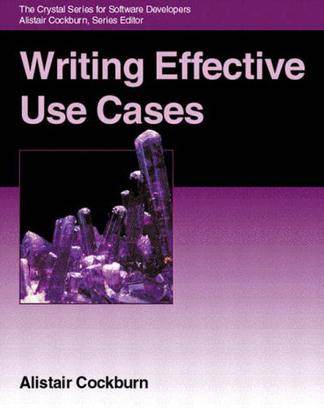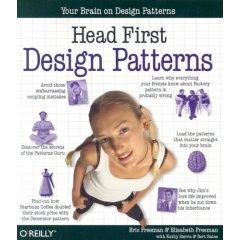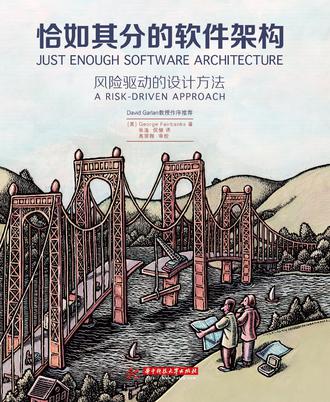-

Joel说软件
这是一本介绍软件管理的小品文集。全书分为45章,每章就是一个独立的专题或者知识点。本书内容十分丰富全面,小到项目负责人制订进度表,大到软件执行总裁提出富有竞争性的战略,都在本书的介绍之列。尽管内容很多,但事例驱动的写作方式,奠定了本书在可学性与可用性方面明显的优势。 本书从不同侧面满足了软件开发人员、设计人员、管理人员及从事软件相关工作的人员的学习与工作需要。 -

Writing Effective Use Cases
Use cases have never been this easy to understand -- or this easy to create! In Writing Effective Use Cases, Alistair Cockburn offers a hands-on, soup-to-nuts guide to use case development, based on the proven concepts he has refined through years of research, development, and seminar presentations. Cockburn begins by answering the most basic questions facing anyone interested in use cases: "What does a use case look like? When do I write one?" Next, he introduces each key element of use cases: actors, stakeholders, design scope, goal levels, scenarios, and more. Writing Effective Use Cases contains detailed guidelines, formats, and project standards for creating use cases -- as well as a detailed chapter on style, containing specific do's and don'ts. Cockburn shows how use cases fit together with requirements gathering, business processing reengineering, and other key issues facing software professionals. The book includes practice exercises with solutions, as well as a detailed appendix on how to use these techniques with UML. For all application developers, object technology practitioners, software system designers, architects, and analysts. -

Head First Design Patterns
You're not alone. At any given moment, somewhere in the world someone struggles with the same software design problems you have. You know you don't want to reinvent the wheel (or worse, a flat tire), so you look to Design Patterns--the lessons learned by those who've faced the same problems. With Design Patterns, you get to take advantage of the best practices and experience of others, so that you can spend your time on... something else. Something more challenging. Something more complex. Something more fun. You want to learn about the patterns that matter--why to use them, when to use them, how to use them (and when NOT to use them). But you don't just want to see how patterns look in a book, you want to know how they look "in the wild". In their native environment. In other words, in real world applications. You also want to learn how patterns are used in the Java API, and how to exploit Java's built-in pattern support in your own code. You want to learn the real OO design principles and why everything your boss told you about inheritance might be wrong (and what to do instead). You want to learn how those principles will help the next time you're up a creek without a design paddle pattern. Most importantly, you want to learn the "secret language" of Design Patterns so that you can hold your own with your co-worker (and impress cocktail party guests) when he casually mentions his stunningly clever use of Command, Facade, Proxy, and Factory in between sips of a martini. You'll easily counter with your deep understanding of why Singleton isn't as simple as it sounds, how the Factory is so often misunderstood, or on the real relationship between Decorator, Facade and Adapter. With Head First Design Patterns, you'll avoid the embarrassment of thinking Decorator is something from the "Trading Spaces" show. Best of all, in a way that won't put you to sleep! We think your time is too important (and too short) to spend it struggling with academic texts. If you've read a Head First book, you know what to expect - a visually-rich format designed for the way your brain works. Using the latest research in neurobiology, cognitive science, and learning theory, Head First Design Patterns will load patterns into your brain in a way that sticks. In a way that lets you put them to work immediately. In a way that makes you better at solving software design problems, and better at speaking the language of patterns with others on your team. -

Joel on Software
This book covers every imaginable aspect of softward programming, from the best way to write a code to the best way to design an office in with to write a code. -

编写高质量代码:改善Python程序的91个建议
在通往“Python技术殿堂”的路上,本书将为你编写健壮、优雅、高质量的Python代码提供切实帮助!内容全部由Python编码的最佳实践组成,从基本原则、惯用法、语法、库、设计模式、内部机制、开发工具和性能优化8个方面深入探讨了编写高质量Python代码的技巧与禁忌,一共总结出91条宝贵的建议。每条建议对应Python程序员可能会遇到的一个问题。本书不仅以建议的方式从正反两方面给出了被实践证明为十分优秀的解决方案或非常糟糕的解决方案,而且分析了问题产生的根源,会使人有一种醍醐灌顶的感觉,豁然开朗。 《编写高质量代码:改善Python程序的91个建议》针对每个问题所选择的应用场景都非常典型,给出的建议也都与实践紧密结合。书中的每一条建议都可能在你的下一行代码、下一个应用或下一个项目中显露锋芒。建议你将本书搁置在手边,随时查阅,相信这么做一定能使你的学习和开发工作事半功倍。 -

恰如其分的软件架构
本书描述了一种恰如其分的软件架构设计方法。作者建议根据项目面临的风险来调整架构设计的成本,并从多个视角阐述了软件架构的建模过程和方法,包括用例模型、概念模型、域模型、设计模型和代码模型等。本书不仅介绍方法,而且还对方法和概念进行了归类和阐述,将软件架构设计融入开发实践中,与 敏捷开发方法有机地结合在一起,适合普通程序员阅读。 . 这是一本超值的书,案例丰富有趣,言简意赅,阅读轻松。当年如果读到这样的书,我可以少犯许多错误!渴望成为更为优秀软件设计师的读者,这本书绝对值得在你的书架上占有一席之地。 ——Timothy J. Halloran博士,SureLogic Inc.工程总监 . 本书提出的独特视角让软件架构设计变得不再难以捉摸。恰如其分的软件架构概念及风险驱动的设计理念让人耳目一新。作者将架构设计原则与现实问题有机地结合起来,值得所有从事软件开发工作的人士阅读。 ——Marcus Fontoura博士,Yahoo! Research首席科学家兼架构师 . Fairbanks把笔墨聚集在“恰如其分”的软件架构上,这对于每一位想要使架构过程变得更容易的开发人员来说,都是极具吸引力的。本书通过详细的案例和建议,展示了如何用风险驱动来管理架构的建设和范围,重点突出,易于理解。同时,作者提供了软件架构学术方面的很多细节,这对那些对理论和实践都很感兴趣的开发人员非常有益。 ——Bradley Schmerl博士,卡耐基梅隆大学计算机科学院资深系统科学家 . George Fairbanks的《恰如其分的软件架构》一书中的风险驱动建模方法已经被NASA Johnson Space Center(JSC)成功地应用于eXtensible Information Modeler (XIM) 项目。项目的所有成员,从项目管理人员到开发人员,都必须遵循。实际上,这本书应该是每一位开发人员的必备工具。仅仅是讲述(代码模型和反模式)的部分,就值回书价了。 ——Christopher Dean, 美国国家航空航天局约翰逊空间中心工程科学团队XIM首席架构师 . 《恰如其分的软件架构》教你如何在战略和战术上使用工具,以及如何为你的软件项目选择架构策略。无论你是一位开发人员还是架构师,本书都是你在架构过程中的必备参考资料。 ——Nicholas Sherman,微软项目经理 . 作者将过程、生命周期、架构、建模及服务质量方面的最新理念集成在一个条理清楚的框架中。这个框架可以立即应用于你的 IT应用。Fairbanks的写作异常清晰、精确,同时具有很高的可读性和趣味性。《恰如其分的软件架构》是IT应用架构方面一个具有重要贡献的文献,对于企业应用架构师来说,也许会成为他们的标准参考资料。 ——Ian Maung博士,花旗企业架构部门资深副总裁,Covance前企业架构总监 . 本书完全满足了那些软件开发实践者的关键需求,即如何有效地创建更加实际的系统。George常常运用自己的经验,并与学术理论相结合,为我们提供一个又一个概念模型、领域(或更广范围)内的最佳实践,以及在软件架构方面(如何更有用更现实)非常实用的指导。他在书中提出了基于风险的架构方法,并帮助我们认识到怎样才是“恰如其分”的。本书的问世为软件架构领域又增添了一份重要的文献。 ——Desmond D’Souza, 《MAp and Catalysis》一书的作者,Kinetium, Inc. . 很多系统和软件开发人员常常追问为什么要做,以及针对什么做软件架构,他们一定会感谢本书的作者在这本书中呈现了清晰的论证和精彩的推理;对于纠结何时,以及如何做架构的开发人员,也会在本书中找到恰如其分的指导,当然还有很多概念和思想。总之,本书简洁易懂,还有很多可供参考的内容——的确是一本架构精到、设计精心的好书! ——Shang-Wen Cheng博士,航空软件工程师 . 如果你打算阅读一本关于软件架构的书,那就选择这一本吧。《恰如其分的软件架构》覆盖了每一位程序员、开发人员、测试人员、架构师、经理都必须知道的软件架构的基本概念,它提供了很多在实战中非常实用的建议,而这只需要你花几个小时去阅读! ——Michael Keeling,专业软件工程师 . 本书展现了软件架构将如何帮助你来构建软件,而不会阻碍软件的构建;本书能够让你关注那些真正值得关注的关键性架构工作,从而避免影响编码工作。 ——Kevin Bierhoff博士,专业软件工程师